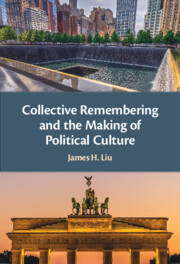Book contents
- Collective Remembering and the Making of Political Culture
- Collective Remembering and the Making of Political Culture
- Copyright page
- Contents
- Preface
- Part I Introduction to Collective Remembering
- Chapter 1 The Rise of Research on Collective Remembering
- Chapter 2 Top-Down Approaches to Collective Remembering
- Chapter 3 Bottom-Up Approaches to Collective Remembering
- Part II Developing a Theoretical Approach to Collective Remembering
- Part III Idiographic Case Studies of Collective Remembering
- References
- Index
Chapter 2 - Top-Down Approaches to Collective Remembering
from Part I - Introduction to Collective Remembering
Published online by Cambridge University Press: 04 August 2022
- Collective Remembering and the Making of Political Culture
- Collective Remembering and the Making of Political Culture
- Copyright page
- Contents
- Preface
- Part I Introduction to Collective Remembering
- Chapter 1 The Rise of Research on Collective Remembering
- Chapter 2 Top-Down Approaches to Collective Remembering
- Chapter 3 Bottom-Up Approaches to Collective Remembering
- Part II Developing a Theoretical Approach to Collective Remembering
- Part III Idiographic Case Studies of Collective Remembering
- References
- Index
Summary
In 1492, Columbus sailed the ocean blue, but on October 11, 1992, the quincentennial Columbus Day parade in the city of Denver, Colorado, was canceled due to fears of violence between Native American protestors and Italian American parade organizers (Hitchmough, 2013). While Columbus celebrations were not as contentious in other parts of the USA, there was more enthusiasm among scholars for presenting him as a villain rather than a hero (Summerhill & Williams, 2000). This was in marked contrast to his heroic status a hundred years earlier (West & Kling, 1989), when the USA was finishing up conquest of its western frontier. In that present, with America on the cusp of becoming a global power, Columbus was the perfect symbol of a heroic past for a people (or, at least, the powerful among them)1 who felt graced by the promise of an unbounded future in 1892. The mood of the nation in 1992 was more postheroic (see Schwartz, 2008). In response to an open-ended query, the vast majority of Americans in 1998 (85 percent; see Schuman et al., 2005) viewed Columbus as the “discoverer of America” but did not embellish this with any heroic qualities. Just as many (6 percent) saw him as villainous or not that great (i.e., other people got there first) as saw him as heroic.
- Type
- Chapter
- Information
- Publisher: Cambridge University PressPrint publication year: 2022



